Part 1: Pop-Up Retail Basics
Chapter 1: History of Pop-Up Retail
Chapter Overview
Temporary stores that create opportunities for customers to engage with a brand have been “popping up” in a variety of places for many years. Otherwise known as pop-up shops, this short-term retail format has a history that dates back many centuries to the earliest known travelling merchants. More recently however, starting in the early 2000s and growing significantly in popularity since, retailers and brand manufacturers have employed the use of temporary locations as part of an omni-channel strategy to build awareness, launch new products and increase sales by appealing to new customers.
Academic research with a focus on pop-up retail has explored how the format may impact consumer attitudes and experiences with a brand. This chapter will introduce some of the earliest examples and newest concepts of pop-ups.
Learning Objectives
Upon completion of the chapter, readers will be able to:
- Identify the historical uses of pop-ups.
- Explain how pop-up shops have evolved to serve different purposes.
- Name potential uses of pop-up operations in other industries.
- Give examples of event-based pop-up practices.
Setting the Context
VIDEO
The following video helps to offer some context to how pop-ups have changed over time with a hypothetical entrepreneur planning his business first as a traveling merchant with a horse-drawn wagon, to the same individual setting up a booth at a music festival, to the modern-day concept of a temporary store-within-a-store.
1. Historical Uses for Pop-Ups
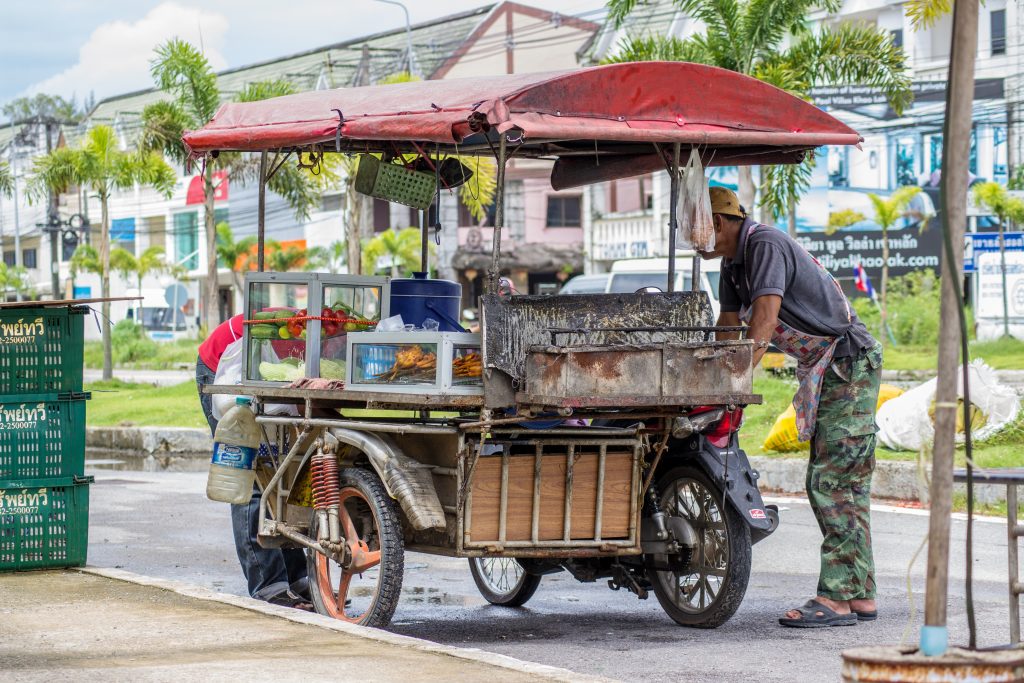
1.1 Traveling Merchants
One of the earliest forms of retail trade involved caravans and travelling merchants who would regularly “pop up” in various locations, bringing with them exotic products such as spices, carpets, fashion and more to new markets across the continent European.
Similarly, during the industrialization of England, John Lie suggests that travelling merchants were important in expanding trade to wider geographic areas than would otherwise be served by traditional markets. He summarizes from Rowlands (1975) and Spufford (1984) that “…many of the leading industries of the Industrial Revolution, such as cloth and iron, relied on travelling merchants to find and create their ‘market’…”1. These merchants would visit different locations on a seasonal or periodic basis, expanding both the demand and distribution for goods that were not regularly available to most customers.
For many years, traditional periodic markets around the globe have provided an opportunity for travelling merchants and part-time entrepreneurs alike to sell everything from fresh seafood and seasonal produce to clothes and housewares. Often located in developing or rural areas, these markets have offered merchants a relatively low-cost way to visit and rent space in a new geographic area each day of the week, introducing new products and innovations to consumers.2
1.2 Farmers’ Markets
The farmers’ market is similar to an ongoing periodic market but typically operates in relation to the growing season of a geographic region. Providing an outlet for independent growers and producers of food items to sell directly to consumers, these markets may open for one day a week through the summer and fall with a combination of regular and short-term vendors in a dedicated area on a street, in a parking lot or at parks and open spaces such as rural fairgrounds. Shoppers can expect to find staple items including carrots, lettuce and tomatoes throughout the season, while other items such as blueberries, cranberries and squash with shorter harvesting seasons may be available exclusively during select months.
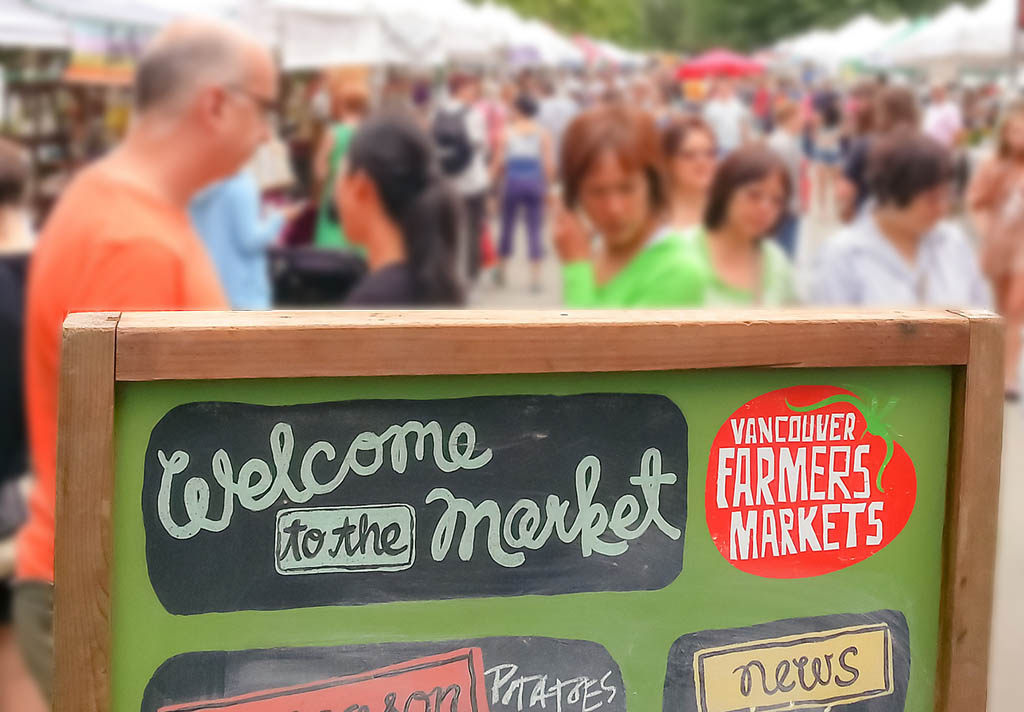
In a study about the history of farmers’ markets in Canada, Michael Basil identified three distinct eras3. The first of these saw the introduction of European-style markets following immigration patterns during the 1800s through the turn of the century. A decline in farmers’ markets corresponded to a rise in industrial farming along with a growing dependence by consumers on general stores and supermarkets. However, a third era from 1970 onward began with the increasing popularity of consumers focused on the environment and eat-local movements.
Today, farmers’ markets are often organized with support from the local chamber of commerce, business improvement area or community groups and serve as a temporary location for retailers with both traditional and innovative products. However, recent shifts in consumer interests toward experiences over products alone may help to re-shape some of the offerings at these markets. In a US survey of 19 to 29 year-olds, the majority expressed an interest in seeing festival-like events at farmers’ markets. “87 percent would like to see cooking demonstrations…74 percent would like kid’s events… Over half of the respondents (61%) would like to see contests, such as food-eating and raffles.”4
Farmers’ markets are already positioned to take advantage of green, organic and local food sourcing trends, but would do well to incorporate unique and constantly changing experiential events into the mix with an eye to attracting young adults along with traditional customers.
1.3 Seasonal Businesses
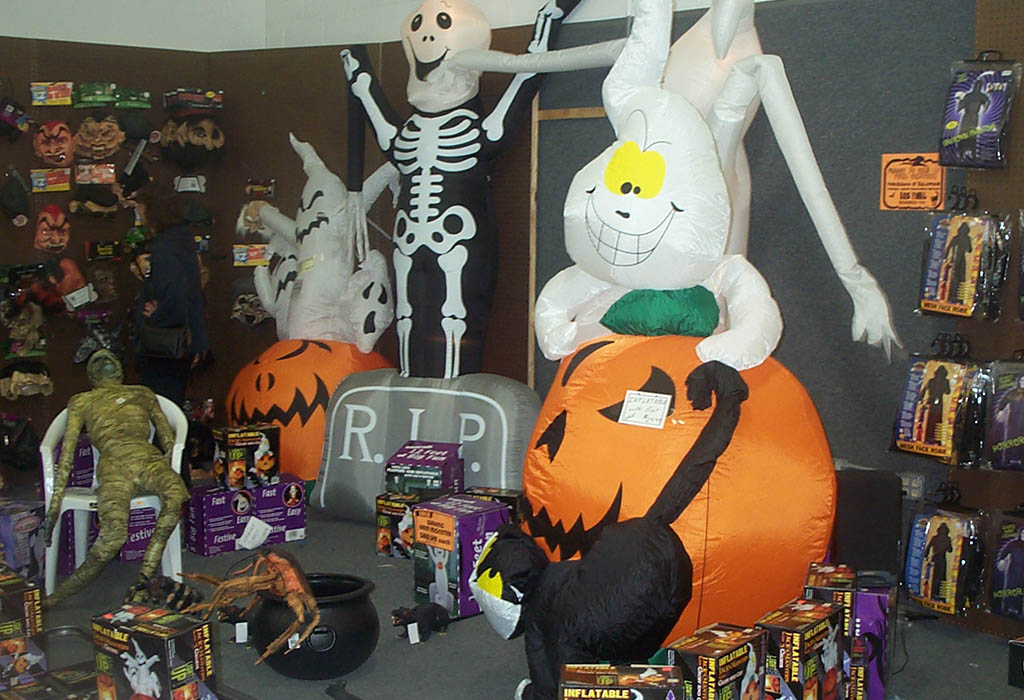
Retailers of seasonal products such as calendars or holiday items for Valentine’s Day, Halloween and the like will pop up each year in vacant shopping mall spaces, street front stores, kiosks or at events. In many ways, these pop-up stores operate as traditional brick and mortar retailers but for a limited time frame of a few weeks or months. They may return to the same markets each year, but source new locations each time based on the availability of vacant spaces.
Spirit Halloween offers a good example of a seasonal pop-up retail format. Founded in 1983 and having grown to over 1,100 locations across Canada and the US, these stores operate from August to November each year and maintain a permanent website to sell costumes, decorations and accessories.5 Halloween is one of several important events for traditional retailers that presents great opportunities for entrepreneurs and pop-up shops. Although this type of business is designed to continue each year on an ongoing basis, new temporary locations may be used each time based on the availability of vacant street front stores, mall space, and other appropriate sites in each market during the season.
Did You Know?
- Statistics Canada reported that candy sales for October 2016 were $66.4 million higher than the monthly average.6
- That same year, a total of 63,945 tonnes of pumpkins were sold for a total of $21.3 million, many for use as Jack-o-lanterns and holiday treats.
- The total value of Halloween-related sales is almost $1 billion annually according to the Retail Council of Canada.7
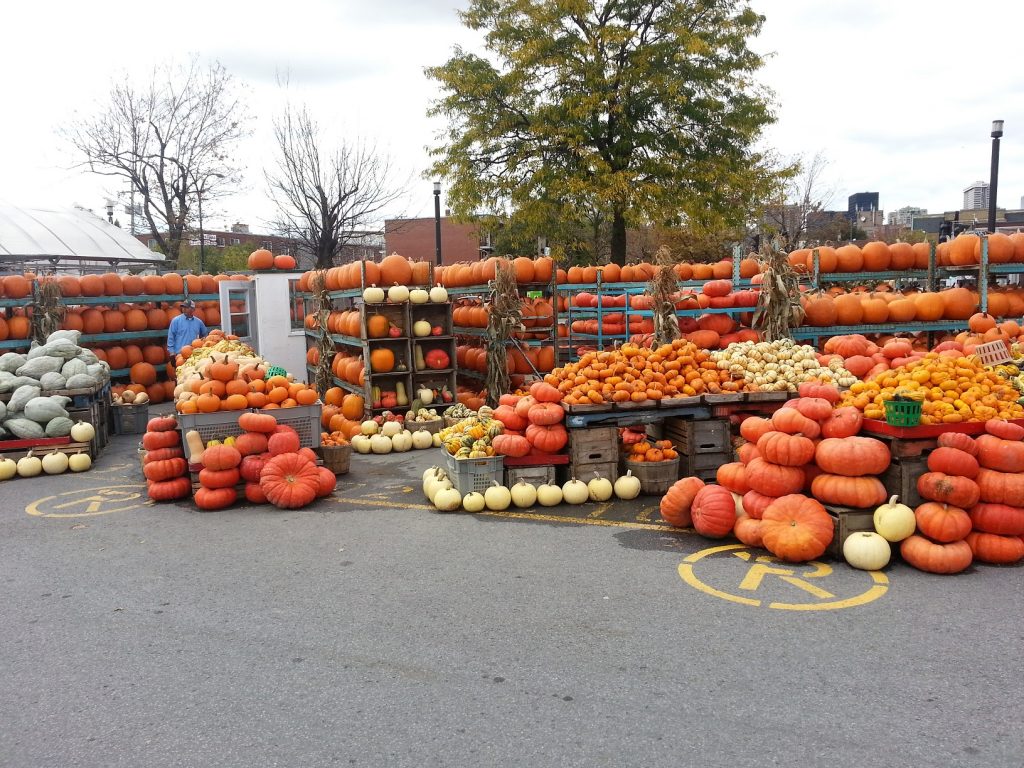
2. The Evolution of Pop-Up Shops
2.1 A New Channel for Direct Engagement With Consumers
While many early examples of retailers “popping up” were temporary by virtue of the markets or seasons in which they were operating (e.g., periodic markets, holiday-themed products, etc.), the pop-up format has evolved to include a greater focus on the customer experience. This includes creating a sense of urgency and exclusivity for “limited time only” events or offering customers the chance to be first to buy new products. Developing business strategies for pre- and post-purchase brand experiences across channels beyond the physical shop itself is a key element of this evolution in the role of pop-ups.
One such evolution arose as pure-play online retailers began experimenting with pop-up models to engage with customers offline and in new ways. These initiatives were sometimes focused on the future by increasing brand awareness among consumers or testing the potential to open permanent physical stores, while others were opportunistic with plans to increase current transactions during select periods without the commitment of long-term leases.
Even giants of e-commerce such as Amazon have experimented with pop-up formats and, for more than a decade, eBay has implemented a number of pop-up concepts around the world. In 2004, the company created a truly omni-channel experience opening up its Manhattan “showhouse” to the public, which featured affordable housewares and decor that had been selected through eBay by eight top interior designers8. The house was part of an A&E television program and the items showcased were made available for purchase during a one week online auction for charity. Since that time, the company has opened pop-ups in locations around the world, featuring select categories or holiday-themed items, and demonstrating innovative uses for technology in-store.
National brand manufacturers, especially non-vertically integrated ones, also began to see that pop-ups offered an opportunity to create direct connections with consumers. Companies ranging from Samsung to Nike to Kraft have used this strategy to build awareness and excitement about new product launches, demonstrate technical features in fun ways and present their brand outside the confines of a retail partner.
Example
Check out this brief video of the KD Fun Shop tour in 2014 and see how Kraft Canada made the pop-up shop concept work.
2.2 Pop-Ups on Wheels
The use of vehicles, shipping containers and other forms of mobile pop-up shops on wheels has been growing in popularity. Food truck-style pop-ups can be seen for categories that may have nothing to do with food, such as mobile fashion boutiques. And when food is the product, these trucks may include unique experiential elements like satellite televisions and roped patio areas beside the vehicle to show a sporting event or videos related to the festivals and markets where they park.
Rather than setting up shop in a vacant store or renting a space at a local market, businesses large and small may use a mobile store to take their product or services on the road, visiting different markets for short periods and sometimes with little to no advance advertising. These mobile pop-ups are a great way to incorporate the element of surprise and take advantage of unconventional opportunities to build a brand and generate buzz through unique offerings.
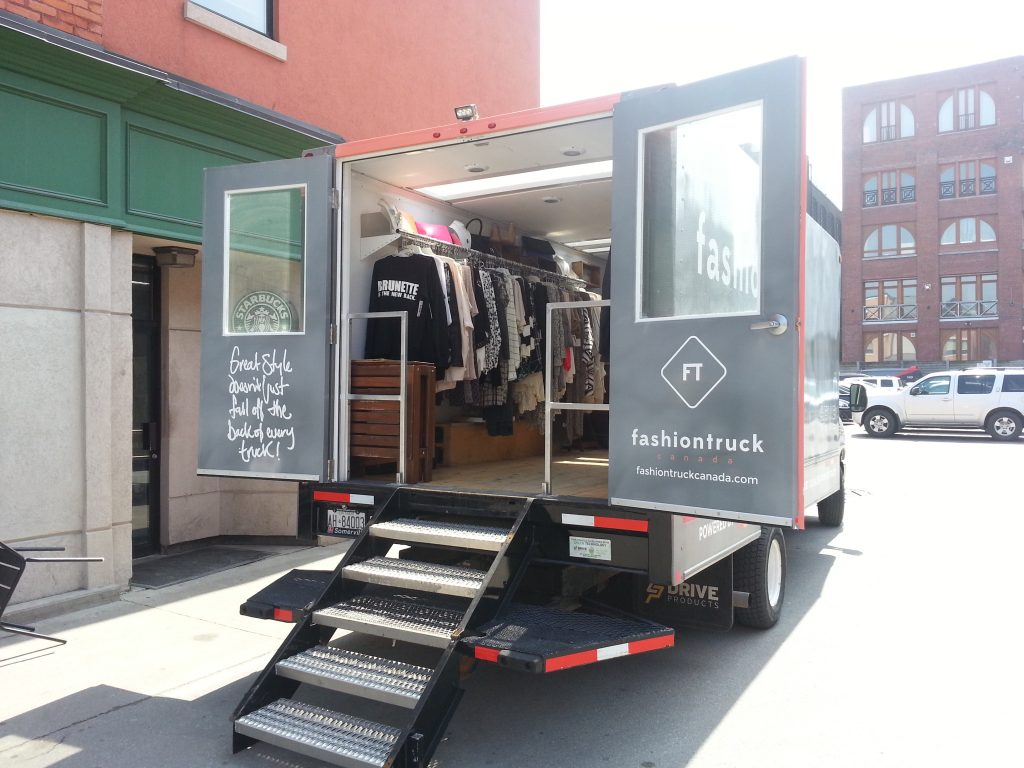
Examples
Here are four examples of fashion boutiques on wheels from across Canada and the United States.
- Fashion Truck Canada (Toronto, Ontario)
- Mobile Boutiques Hitting the Streets of Denver (Denver, Colorado)
- Le Fashion Truck (Los Angeles, California)
- “In Pursuit” Fashion Truck (Saint John, New Brunswick)
2.3. Retailers Take Pop-Ups Beyond Their Own Walls
In the early 2000s, retailers themselves began experimenting with the pop-up format as a way to create new and memorable experiences for their customers and re-energize their brands. Collaborating with featured designers or offering a sneak peek at new collections before their official launch catered to shoppers who seek opportunities to be the first to experience and own products before their peers.
Target Corporation was one of the earlier retailers to make use of the pop-up format on a grand scale across North America to highlight collaborations with popular designers, promote new store openings and create memorable experiences that coincide with the launch of new product lines. Two such examples include a New York City pop-up in the fall of 2003 featuring a new women’s apparel collection by Isaac Mizrahi and the Bullseye Inn that was launched in spring 2004 as a unique way to present new summer items leading up to July 4th.
2.4 Extending Store-in-Store Concept to Pop-Ups
Short-term pop-ups within traditional stores are another evolution of the format for retailers and manufacturers alike. The store-within-a-store concept is well known to shoppers, particularly in major department stores. However, extending this idea to shorter-term concepts, retailers may choose to host a pop-up within their own space for a number of reasons.
Creating a sense that shoppers can expect to find something new and exciting may help to increase traffic to the rest of the store. Partnering with key suppliers may offer enhanced opportunities for consumer education about products without requiring additional staffing/training by the store. Featuring items by local or well regarded retailers in non-competing categories may help to enhance the image of the host retailer. Amidst a shift to downsizing retail footprints, offering internal space to pop-ups can create additional revenue streams to the retailer in the form of new rent, increased foot traffic and as a draw for customers to return regularly and see what’s new in-store.
2.5 Evolution From Pop-Up Shops to Pop-Up Malls
As illustrated already, pop-ups and markets often go hand-in-hand with farmers’ markets, craft markets, holiday markets and more. The next evolution in this area may be the appearance of “pop-up shopping malls” such as those developed by Boxpark in England.
Originally established in 2011, the concept delivers a variety of shopping, entertainment and food experiences with a street front atmosphere built around reimagined shipping containers. At the time that the concept launched, Jay Ryu noted that the pop-up mall uses community space and provides a lower cost alternative for brands to set up a physical store. He also suggested that, “Since the pop-up shopping mall is a collage of movable shipping containers, it can easily travel from one location to another and one foreign market to another.”9 In theory this is true, but in practice the Boxpark model since then has been to establish additional shipping container malls in new locations rather than closing and moving the original mall from place to place. However, individual brands such as Puma have used this model to create an experience around their brand featuring cafes and showrooms constructed from multiple shipping containers that travel to different locations.
2.6 Community Revitalization
As communities, neighbourhoods and the demographic mix in an area change over time businesses may move away, leading to vacancies in street level retail spaces that can pose several challenges. Having too many empty storefronts in one area may contribute to a cycle of lowering foot traffic, increasing safety concerns, and negatively impact property values along with the overall sense of community among residents. In 2008, the Renew Newcastle project in Australia began “connecting people with vacant spaces”10 in underutilized neighbourhoods to address these types of challenges and has since been a model for others to replicate around the world – including in Canada by the Danforth East Community Association.
3. Pop-Up Operations in Other Industries
3.1 Travelling Cinemas and Theatre Shows
Pop-up experiences centred around watching films away from a traditional movie theatre have taken shape in two distinct ways over the past century. In urban and suburban areas, hosting an outdoor film festival or movies in the park on summer weekends is a way to build community engagement while sometimes attracting pop-up vendors with food and complementary items available for sale on-site. Travelling cinemas, similar to a travelling circus, are another example where film and a pop-up format are combined to bring the movie watching experience to people in rural areas.
Example
The Cinema Travellers is a documentary film that was released in 2016 and tells the story of how showmen bring mobile movie experiences to rural communities in India.
- Visit the film’s official website.
- Watch the BBC’s Tom Brook report on the film.
Travelling theatre companies follow a similar model and besides the traditional village theatre stage, some bring particularly novel ideas to pop-ups in select communities. The Amara Zee Caravan Stage Company travels and hosts its own performances on a 90-foot tall ship that has sailed to ports from North America to Europe bringing live tales to coastal audiences.11 The Smile Theatre company, on the other hand, was created as an official charity to help enrich the lives of seniors by travelling to and performing for those living in extended care communities.12
3.2 Tourism Pop-Ups
There is some debate about the degree to which consumer spending has recently seen a shift away from accumulating products and toward finding new experiences. However, tourism in Canada generates close to $16 billion annually13 with only one-fifth of that coming from in-bound tourists.
As people seek more weekend vacations, road trips to unique destinations and high end restaurants by making spontaneous decisions without long-term plans, many travel and tourism related businesses use a pop-up strategy to sell tickets and vacation packages. In an attempt to attract more international tourists to visit Canada, the consulate in Macao launched a pop-up in 2016 to attract and inform people in Hong Kong about the opportunities to visit, invest or live in Canada.14 This temporary form of tourism promotion is one more example of how pop-up formats can be tailored to go where a particular target market is located.
4. Event-Based Pop-Up Practices
4.1 Fairs, Festivals and Concerts
Cultural events, food festivals and concerts offer another platform for pop-up vendors to promote their brands and bring their wares to consumers while contributing to the creation of a unique overall experience.
The organizers of arts and food festivals along with the regions that host them often recognize that such festivals create value to multiple stakeholders, but measuring the economic impact is sometimes difficult. In Australia, the “Arts Victoria Do-it-Yourself economic impact assessment kit (DIY kit)” was developed using an input-output analysis model that is simple enough for small- to medium-scale events to use and showed the first seven that were tested led to economic benefits from $26,000 to $3.3 million depending on their size.16 This type of tool may help festival organizers to better market their event to potential sponsors, pop-up vendors and consumers at large.
Much like festivals, concerts that are held outside of traditional stadium venues often attract a range of pop-up vendors in addition to offering merchandise for sale by the musicians and artists performing. More recently, major recording artists have been extending the pop-up model to create a temporary store for their concert merchandise in a location that is accessible to fans who are unable to attend the show. Kanye West is likely the most successful example of this after launching his pop-ups in 21 international cities to coincide with the St. Pablo world tour.17 These superstar-driven models present an element of exclusivity and extend their ability to sell more merchandise directly to consumers.
4.2 Warehouse Sales
While at first warehouse sales may not sound as exciting as some of the modern experiential pop-up shop concepts vying for the attention of today’s consumers, when done well, this format can serve as an effective component of a retailer’s strategy while engaging consumers in a new way. Retailers from Aritzia to Nordstrom host warehouse sales to clear end-of-season inventory at a location outside of their traditional stores and consumers may benefit not only by saving money, but also through the hedonic value of hunting and finding a great deal to share with their friends. Arnold and Reynolds describe value shopping as an experience “almost as if shopping is a challenge to be ‘conquered’ or a game to be ‘won'”.18 Retailers who approach the warehouse pop-up with this in mind may have a perfect format to integrate into their social media strategy, encouraging shoppers to share their wins with friends and in turn increase the brand’s reach beyond the event itself.
4.3 Craft Shows
Craft shows are another example of a type of marketplace with a long history as a platform for pop-up vendors, particularly independent artisans. Toronto’s “One of a Kind Craft Show” dates back over 40 years to 1975 and now features over 800 “makers” and small business owners during an 11-day event where shoppers pay up to $15 each for admission before even making a purchase.19 While this is an example of a grand scale show, some holiday markets may feature only 20-30 vendors and consumers may find similar events throughout the year in their own towns and cities to suit their personal tastes and preferences.
Tieman and Barbour note that in the US, there are thousands of craft shows and fairs that may range from a single day to a week or longer and each has a distinctive feel that is often targeted to either style-conscious shoppers or those who are value and price-focused.20 This distinction is important, as any retailer knows, because considering the right location to pop up depends on knowing where your primary customer is likely to be.
4.4 Fashion Weeks
In the minds of many, pop-up shops are intrinsically linked with fashion. Major fashion week events around the globe attract media, sponsors, celebrities and yes, associated pop-up vendors. Increasingly, these events are being used by major brands from Maybelline to Kendall and Kylie Jenner as a platform to present more ready-to-wear and ready-for-sale items to consumers beyond the couture collections of the runway.21
Key Takeaways
In this chapter, you learned:
- about the history of the temporary store or pop-up format ranging from markets and travelling merchants to the evolution of the concept into an important part of a marketing strategy for large brands, online retailers and entrepreneurs
- how pop-ups are used by different industries, such as travel and tourism, in addition to the typical retail/consumer products industry
- some examples of linking a pop-up initiative to a larger event or marketplace rather than a standalone shop
Key Terms:
- Pop-Up Shop
- Periodic Market
- Planned Spontaneity
Mini Case Study
Office Shop
Situation:
A large office supply retail chain has hundreds of traditional stores; however, due to the growth in online shopping, the wide distribution of their target market and other major factors, fewer and fewer people are actually walking into their retail stores. Additionally, many of their marketing campaigns, including heavy discounts on certain items, have not converted into additional foot traffic and sales.
The retailer needs a new, innovative, low-cost, repeatable, attention-grabbing method to reach out to potential customers, and draw them into their retail locations.
Solution:
Large retailers are used to dealing with overhead costs and traditional marketing such as radio, newspaper, television and online advertisements, most of which can be expensive. However, they are usually less familiar with operating small or temporary locations (such as a pop-up shop) as a means to meet their marketing goals. A satellite location that is mobile, easy to set up and take down, can move locations and adjust its message and content can be a low-cost, highly visible, and strategically innovative way to reach new customers. Pop-up shops offer major retailers and brands the opportunity to invest relatively little into a temporary location that can serve as an awareness and marketing tool, help reach new markets, be flexible and repeatable – and even travel across the country.
Results:
The Office Shop pop-up was a major success. Its location was in the heart of a major city unlike typical Office Shop locations that are scattered throughout the suburbs. This strategy enabled the business to reach a whole new target market, namely those in the downtown core who had limited prior knowledge or motivation to visit their bricks-and-mortar stores in the suburbs.
In addition, the pop-up demonstrated a variety of items that may surprise and excite customers. Having a traditional image as a provider of office technology, paper, and pens, Office Shop chose to feature products that were very colourful in unique and engaging ways. There was a video game area that customers were encouraged to try, colouring and crafts sections with live classes for parents and children and even a sample dorm room to illustrate the options available for college and university students to decorate beyond the typical office furniture that one may expect.
Most people who visited were pleasantly surprised to learn about the products offered at Office Shop and the initiative led to an increase foot traffic and sales at their large permanent stores. Additionally, the pop-up was dismantled and readied for its next location in the near future.
Consider the following questions:
- Identify some potential objectives and formats for Office Shop’s pop-up shop.
- How might using a “pop-up on wheels” help Office Shop to reach their marketing goals?
- How could Office Shop use traditional marketing in conjunction with their pop-up shop?
References
- Lie, J. (1991). Embedding Polanyi’s market society. Sociological Perspectives, 34(2), 219-235.
- Park, S. (1981). Rural development in Korea: the role of periodic markets. Economic Geography, 57(2), 113-126.
- Basil, M. (2012). A history of farmers’ markets in Canada. Journal of Historical Research in Marketing, 4(3), 387-407.
- Oths, K. S., Manzella, F. J., Sheldon, B., & Groves, K. M. (2016). Who will be served? Farmers market variability and the expectations of young adults. Human Organization, 75(4), 351.
- About Us. (n.d.) Spirit Halloween official website.
- Statistics Canada. (2017, October 26). Hallowe’en…by the numbers. Retrieved from: http://www.statcan.gc.ca/eng/dai/smr08/2016/smr08_211_2016
- Shaw, H. (2014, October 25). The $1-billion fright economy: How Canadians are now outspending Americans on Halloween. Financial Post.
- Press Release. (2004, April 8) Eight Of Interior Design’s Hottest Stars Take On The Ultimate Decorating Challenge: The 2004 Ebay Showhouse. Ebay.com.
- Ryu, Jay Sang. (2011). Consumer attitudes and shopping intentions toward pop-up fashion stores. Journal of Global Fashion Marketing, 2(3), 139-147.
- Anonymous. (2018, September). About Renew Newcastle. Retrieved from: http://renewnewcastle.org/about/
- Anonymous. (n.d.) Amara Zee Caravan Stage Company website. Retrieved from: http://caravanstage.org/amarazee.
- Anonymous. (2016). About Us – Smile Theatre website. Retrived from: http://smiletheatre.com/about-us/.
- Theckedath, Dillan. (2014, July 9). Canada’s Tourism Economy. Library of Parliament.
- Government of Canada (2016, February 16). Pop-up Canada! in Macao.
- Trendwatching. (2003, December). Planned Spontaneity.
- Jackson, J., Houghton, M., Russell, R., & Triandos, P. (2005). Innovations in measuring economic impacts of regional festivals: a do-it-yourself kit. Journal of Travel Research, 43(4), 360-367.
- Yotka, S. (2016, August 26). How the merch gets made—a behind-the-scenes look at Kanye West’s pop-up shops. VOGUE.
- Arnold, M. J., & Reynolds, K. E. (2003). Hedonic shopping motivations. Journal of Retailing, 79(2), 77-95.
- One of a Kind Show & Sale. (2017). Why Visit One of a Kind?
- Tiemann, T., Barbour, J. (2006). American crafts shows: price or style conscious? International Journal of Sociology and Social Policy, 26(7/8), 342-352.
- Bauknecht, S. (2016, September 13). Fashion week expands its reach with public events, pop-up shops. Pittsburgh Post–Gazette.

